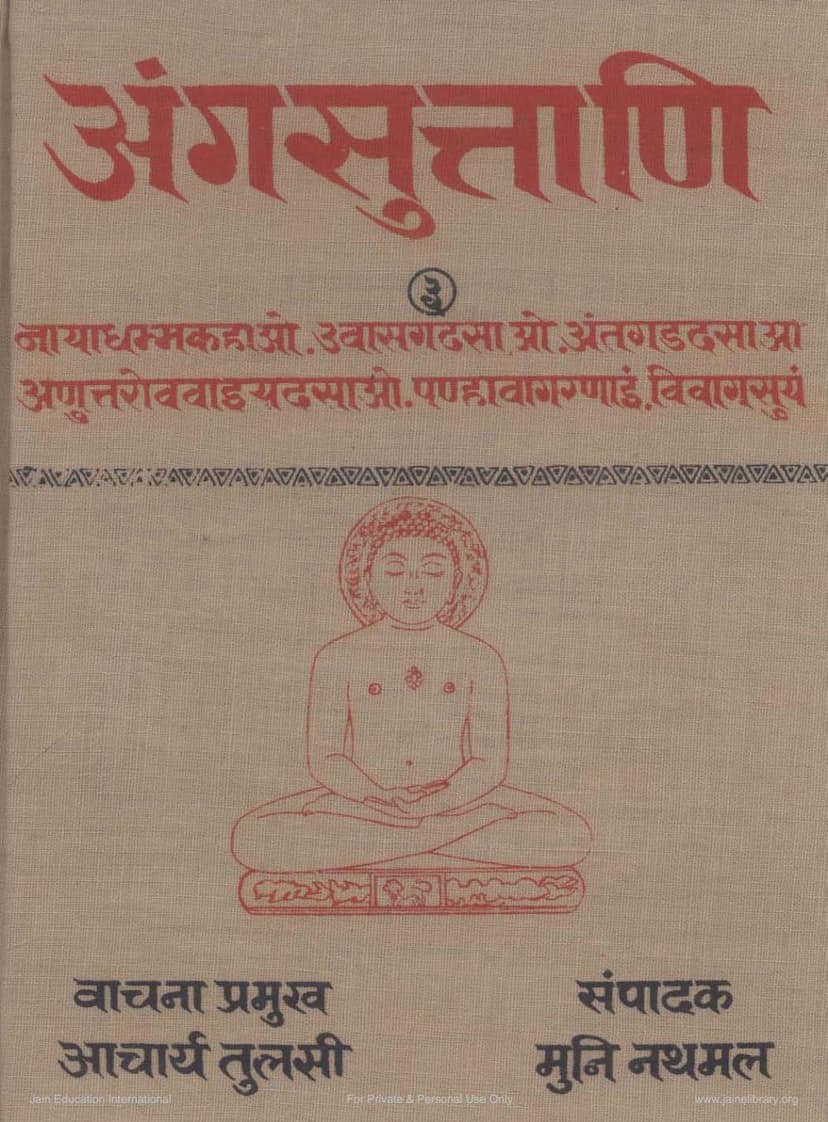Agam 06 Ang 06 Gnatadharma Sutra Nayadhammakahao Terapanth
Added to library: September 1, 2025

Summary
Agam 06, Anga 06: NAYADHAMMAKAHÃO - Comprehensive Summary
This summary provides an overview of the Jain text Nayadhammakahao, the sixth Anga of the Agam Sutras, as presented in the provided pages. The text, critically edited by Acharya Tulsi and edited by Muni Nathmal, was published by Jain Vishva Bharati. It is part of a larger series of Agam publications.
Overall Purpose and Context:
- The Nayadhammakahao is the sixth Anga (section) of the twelve Angas of Jain Agamas.
- It is part of a larger project by Jain Vishva Bharati to critically edit and publish the Jain Agamas, commemorating the 2500th Nirvana anniversary of Lord Mahavira.
- The text is presented in three volumes, with this specific volume focusing on the sixth Anga, Nayadhammakahao, along with five other Angas in the third volume (Uvasagadasao, Antagadadasao, Anuttarowawaiyadadao, Panhavagarana, and Vipaka Sutra).
Structure and Content of Nayadhammakahao:
- Title Meaning: The title "Nayadhammakahao" is derived from two Prakrit words: "Naya" (meaning examples or illustrations) and "Dhammakahao" (meaning religious fables or narratives). Thus, the text primarily comprises illustrative religious stories.
- Two Śrutaskandhas: The sixth Anga is divided into two Śrutaskandhas (sections of scripture):
- Naya (Nātā): The first Śrutaskandha, focusing on examples or illustrative individuals.
- Dhammakaha (Dharmakathā): The second Śrutaskandha, containing religious narratives.
- Number of Adhyayanas: The text is stated to have twenty-one Adhyayanas (chapters or lessons).
- Subject Matter: The Nayadhammakahao expounds spiritual principles such as non-violence, control of senses, faith, and self-restraint through various stories. These stories are presented in a rich and engaging style, sometimes evoking memories of classical prose works.
- Key Features of Narratives:
- Illustrative Stories: The text is characterized by its numerous illustrative stories, drawn from various life experiences.
- Descriptive Elegance: The narratives are noted for their descriptive quality, making them lively and engaging.
- Moral and Spiritual Lessons: Through these stories, the text imparts lessons on dharma, karma, ethical conduct, and spiritual development.
- Examples of Vivid Descriptions: The text highlights specific descriptions that are considered particularly noteworthy, such as the description of a sinking boat in the ninth Adhyayana and the method of purifying water in the twelfth Adhyayana, which illustrates the transformability of matter.
- Illustrative Anecdotes: The inclusion of subsidiary stories and anecdotes, like the well-known fable of the well-frog, adds depth and relatability to the spiritual teachings.
- Comparative Study Potential: The text's rich collection of stories, descriptions, and word usage makes it significant for comparative studies with global fable traditions, potentially revealing new insights.
Editorial and Publication Details:
- Vachana Pramukh (Chief Preacher): Acharya Tulsi
- Editor: Muni Nathmal
- Managing Editor: Shreechand Rampuria
- Financial Assistance: Sri Ramlal Hansraj Golchha, Biratnagar (Nepal)
- Publication Date: Vikram Samvat 2031, Kartik Krishna 13 (corresponding to the 2500th Nirvana Day).
- Pages: 625 (in the original Hindi publication)
- Price: Rs. 80/-
- Printers: S. Narayan & Sons, Delhi.
Specific Mention of Adhyayanas:
The provided pages also include detailed chapter-wise summaries or "Visayanukram" (Index of Subjects) for the first Adhyayana of Nayadhammakahao. This section lists the subject matter covered in each verse (Sutra) of the first Adhyayana, including:
- Ukkhiptana (Invocation/Introduction): Verses 1-73 covering the initial narrative elements, dreams, their interpretation, and the introduction of characters.
- The First Adhyayana (Ukkhiptana): This chapter details the story of King Seniya, Queen Dharini, Prince Abhay, and their interactions related to Queen Dharini's pregnancy and divine events.
- Second Adhyayana (Sanghata): Mentions the story of Dhanasresthi and Vijay Takar.
- Third Adhyayana (Anda): Focuses on the story of Mayuri Anda (peacock egg).
- Fourth Adhyayana (Kurma): Deals with the tale of Kurma (tortoise) and Pavasiyala.
- Fifth Adhyayana (Selaga): Narrates the story of King Selaga.
- Sixth Adhyayana (Tumbe): Covers the story of Indra and the gourd.
- Seventh Adhyayana (Rohini): Discusses the story of Rohini.
- Eighth Adhyayana (Malli): Includes the story of King Mahabala and his penance, and later the story of Malli.
- Ninth Adhyayana (Mayandi): Features the story of Mayandi and the well-frog.
- Tenth Adhyayana (Chandima): Discusses the story of Chandima.
- Eleventh Adhyayana (Davadaave): Illustrates the concept of consequences through stories.
- Twelfth Adhyayana (Udaka): Explains the purity and impurity of water, symbolizing spiritual purification.
Editorial Approach and Methodology:
The text emphasizes that the critical editing process does not rely on a single manuscript. Instead, it is based on a thorough analysis of various textual traditions, considering their meaning, contextual coherence, and interpretation by commentators. This critical approach aims to establish the most authentic and accurate original text.
Dedication:
The text is dedicated to "Jayacharya" and "Kalugani," honoring their contributions to the study and dissemination of Jain Agamas.
Overall Significance:
The publication of the Nayadhammakahao and other Anga Suttas is a significant undertaking, making these foundational Jain scriptures accessible to the public in a critically edited and well-researched format. It serves as a vital resource for Jain scholars and devotees seeking to understand the rich narrative tradition of Jainism.